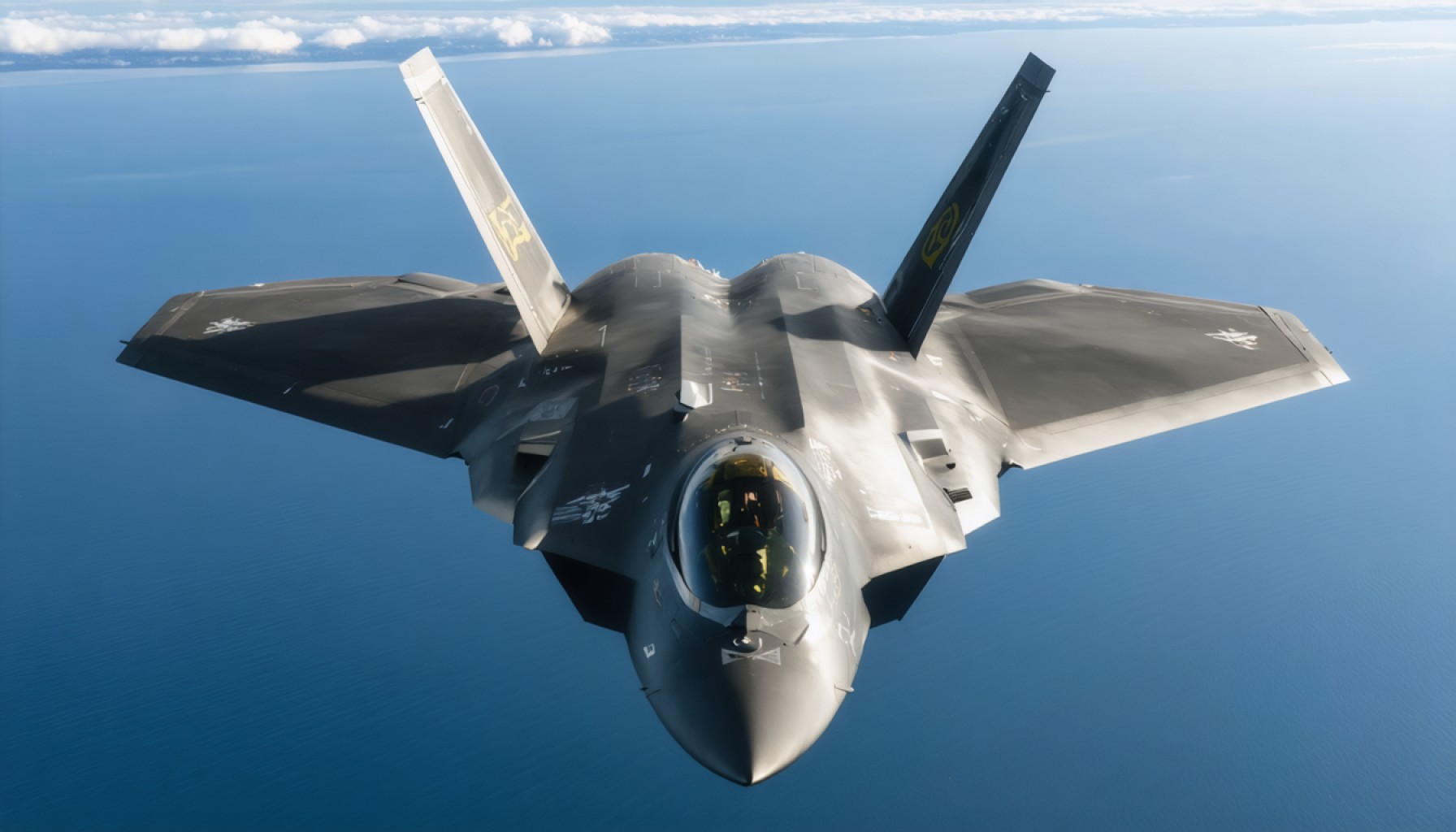- Denmark’s F-35 fighter jets intercepted a Russian Il-20 Coot-A, marking a key defense milestone in the Baltic region’s geopolitical tensions.
- This mission highlights Denmark’s commitment to NATO Quick Reaction Alert protocols, emphasizing advanced technology in national defense.
- A fleet expansion to 27 F-35s by 2025 signifies a strategic shift from F-16s, strengthening Denmark’s aerial capabilities.
- The F-35’s readiness reflects Denmark’s strategic foresight, contributing to NATO’s deterrence and collective security efforts.
- The operation underscores Denmark’s enduring military cooperation with the United States amidst global defense discussions.
- The F-35s symbolize vigilance and resilience, reinforcing Nordic security and promoting shared ideals of freedom and security.
Vividly greeting dawn in the northeastern skies, Denmark’s state-of-the-art F-35 fighter jets launched into a clear blue expanse, marking a historic milestone for the Royal Danish Air Force. These sleek aircraft pierced the Baltic winds with purpose, intercepting a Russian Il-20 Coot-A, a tactical maneuver that signals Denmark’s renewed commitment to defense and sovereignty in a region simmering with geopolitical tension.
Upon their silent take-off from Fighter Wing Skrydstrup, the F-35s glistened under the early light as they sped towards the Baltic Sea. Ground radars had already locked onto the Russian ISR (Intelligence Surveillance Reconnaissance) aircraft, and Danish pilots, with precision and vigilance, identified and shadowed the Coot-A. As part of the Quick Reaction Alert (QRA) protocol, this mission underscored not just a routine patrol but the dawn of a new era, deploying advanced technology to safeguard Denmark’s skies over international waters near Bornholm.
The Russian plane maintained its track over the Baltic, steering clear of Danish airspace but close enough to prompt a watchful escort. This scenario is all too familiar in the NATO theater, yet the involvement of these cutting-edge jets carries a stark reminder of the region’s fragile peace. The tension sparked by Russia’s ongoing conflict with Ukraine underlines the pressing need for collaborative security among Nordic nations and their allies.
These patrols, eyes sharp on the horizon, exemplify Denmark’s resolute investment in defense. A fleet of 17 F-35s out of a planned 27 heralds a gradual shift from the reliable F-16s, a transition poised to conclude in 2025. For now, both aircraft continue their dance in Denmark’s defense strategy, balancing immediate response capabilities and the nuanced mastery required of the F-35.
The mission’s significance extends beyond mere military posturing. The swift readiness of these aircraft, prepared even before the April 1 operational start date, speaks volumes about Denmark’s strategic foresight and operational dexterity. As Danish Defense Minister Troels Lund Poulsen emphasized, enhancing Denmark’s aerial prowess through bolstering the F-35 fleet is essential, viewing it as indispensable within NATO’s collective deterrence matrix.
Echoes of global defense politics reverberated through Denmark’s airbases, as debates swirled over continued military cooperation with the United States amid shifting political tides. While speculation about potential electronic vulnerabilities in the F-35s cast doubts, Denmark’s commitment remains unwavering—a testament to over 75 years of joint defense initiatives that spun into tale the web of transatlantic alliance.
As Denmark steers its F-35s into the theater of the skies, they embody not just machines of war but beacons of vigilance, resilience, and alliance, protecting the delicate balance of peace. These cutting-edge jets have transformed Denmark’s defense posture, heralding a future where advanced technology fortifies not just borders, but the ideals of freedom and security shared across continents.
Denmark’s F-35 Jets: Transforming Nordic Defense in a New Geopolitical Era
Unveiling the New Era of Danish Defense: F-35 Stealth Fighters
The Royal Danish Air Force’s recent deployment of F-35 fighter jets marks a significant milestone in both technological advancement and geopolitical strategy. This development emphasizes Denmark’s commitment to national defense, regional stability, and alignment with NATO’s defensive posture. Here, we delve deeper into the strategic implications, technological advancements, and future outlook of Denmark’s enhanced air force capabilities.
The F-35: Features and Specifications
The F-35 Lightning II is a fifth-generation multirole stealth fighter known for its advanced design and capabilities:
– Stealth Technology: The F-35’s design minimizes radar cross-section, making it difficult for enemy systems to detect. This stealth capability is crucial for both reconnaissance and surprise tactical operations.
– Sensor Fusion: Integrates sensor data into a real-time, seamless stream of information, offering pilots unparalleled situational awareness. This feature is critical in complex airspace environments.
– Network-centric Warfare: F-35s are equipped to share data with other aircraft, command teams, and troops on the ground, acting as a force multiplier.
– Advanced Avionics: Provides pilots with enhanced target-tracking capabilities and the ability to engage multiple targets simultaneously.
Real-World Use Cases and Strategic Importance
1. NATO Interoperability: Denmark’s F-35 acquisition underscores the importance of interoperability within NATO. The F-35s can seamlessly integrate into the alliances’ defensive infrastructure, aligning with collective strategic goals.
2. Geopolitical Deterrence: With tensions high in the Baltic region, these jets act as a deterrent to aggressive maneuvers by reinforcing Denmark’s sovereignty and defense readiness.
3. Fast Response and Quick Reaction Alert (QRA): The ability to rapidly deploy these aircraft as seen in the interception of the Russian Il-20 demonstrates Denmark’s commitment to protecting its airspace and monitoring international waters.
Industry Trends and Future Outlook
– Fleet Transition: Denmark plans to transition from F-16s to a fleet of 27 F-35s by 2025. This replacement signifies a strategic shift towards more advanced, technology-driven defense capabilities.
– Increased Defense Spending: Reflecting global trends, Denmark is likely to increase defense spending to support the F-35 program and other modernization efforts, leading to enhanced national security.
– Collaborative Defense Initiatives: There is an increasing move towards collaborative defense projects with neighboring Nordic countries to bolster regional security.
Controversies and Limitations
– Cost Concerns: The F-35 program is one of the most expensive military projects, with critics pointing to its high acquisition and operational costs.
– Electronic Vulnerabilities: Potential cybersecurity threats have been a talking point, as the F-35’s advanced systems rely heavily on network integration.
Actionable Tips for Understanding Strategic Air Defense
1. Stay Informed: Follow credible defense news sources to stay updated on military developments and strategic defense initiatives.
2. Explore Defense Technology: For those interested in aerospace technology, delve into technical publications and documentaries about aircraft like the F-35.
3. Participate in Discussions: Engage in forums and discussions with defense and aerospace experts to gain diverse perspectives.
4. Visit Airshows and Exhibits: If possible, visit airshows and defense exhibitions to see these technologies in action and learn directly from industry professionals.
The F-35 fighter jets’ arrival in Denmark represents not merely a technological upgrade but a strategic enhancement crucial for contemporary defense strategies. As these swift birds of steel take to the skies, Denmark positions itself at the forefront of modern, interoperable defense, safeguarding not only its own airspace but contributing to the collective security of the region.
For more information on defense technologies and Denmark’s strategic military endeavors, visit the Danish Defense’s official website.







